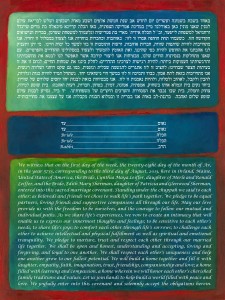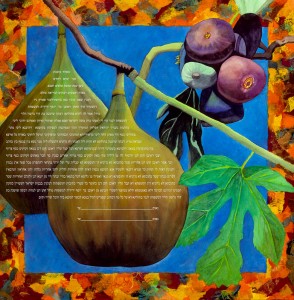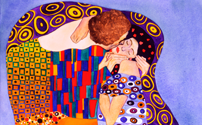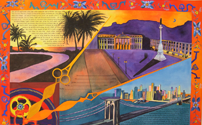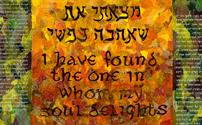As of 2013, Nishima has been making ketubahs, or ketubot, for 15 years. She has worked with close to 3,000 couples and rabbis to create a wide range of ketubahs, or illustrated ketubah contracts. She was at the forefront of the movement to bring this ancient tradition into the modern art world. Here she discusses her knowledge and experiences.
Ketuvah means writing and essentially the ketubah is a written contract that is signed during the Jewish wedding ceremony. The traditional ketubah text is written in Aramaic and harkens back to ancient times as a protection for the wife. Over time this Aramaic ketubah became a requirement for a legal, or halakhic, marriage in the Orthodox world. In modern times, however, many rabbis and Jewish couples prefer to use a different text for their ritual ketubah. Whatever text is used, the ketubah is a central character in the Jewish wedding.
One reason the ketubah is so important in the modern Jewish wedding is due to the beautiful art forms that decorate the ketubah text. Although for centuries it was an illustrated document, for many decades of the modern era, couples were given a black and white photocopy of a ketubah text to file away after their wedding. During the last decades of the twentieth century, artists began again to illustrate ketubahs. However, they looked to ancient Jewish illustrations to inspire their artistry. It was only at the very end of the twentieth century that couples began to ask for truly modern art ketubahs. Today, couples can choose from hundreds of modern art ketubahs that reflect the artistry of 21st century art. The ketubah is a reflection of the couple. The art and the text both speak volumes about their relationship to Jewish community and contemporary art forms.
The ketubah is signed by at least two witnesses. Often the rabbi, bride and groom also sign the modern ketubah. The ritual of signing the ketubah is a solemn part of the Jewish wedding ceremony. Often the ketubah is read out loud. If the English section contains marital vows, the entire congregation witnesses the vows and the signing of these vows. Since the modern ketubah is beautiful and artistic, couples will frame and hang their ketubah in a central spot in their homes. Thus their wedding vows and their connection to Judaism through ancient Hebrew or Aramaic will be visible to all who visit their home.
As one couple told me, their ketubah was the most lasting part of their entire wedding day. On this day, everything was beautiful and reflective of the deeply meaningful ceremony that brought them together in commitment to each other. But at the end of the day, everything was put away and they were left with photos and memories. Except for their ketubah, which they took home to live with them in all its beautiful, meaningful glory.



